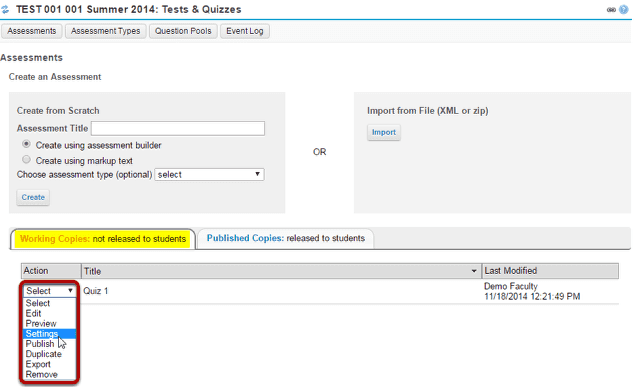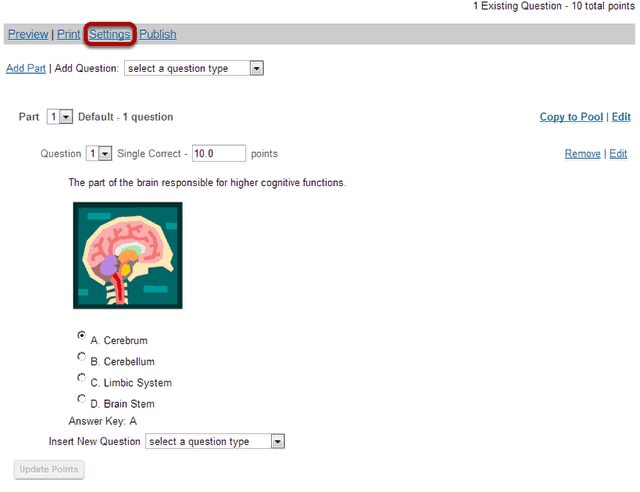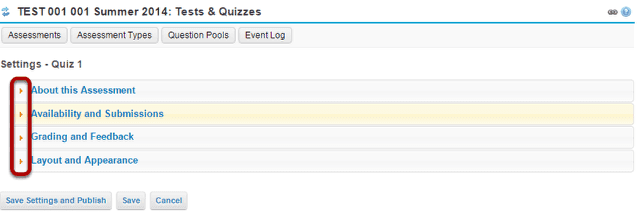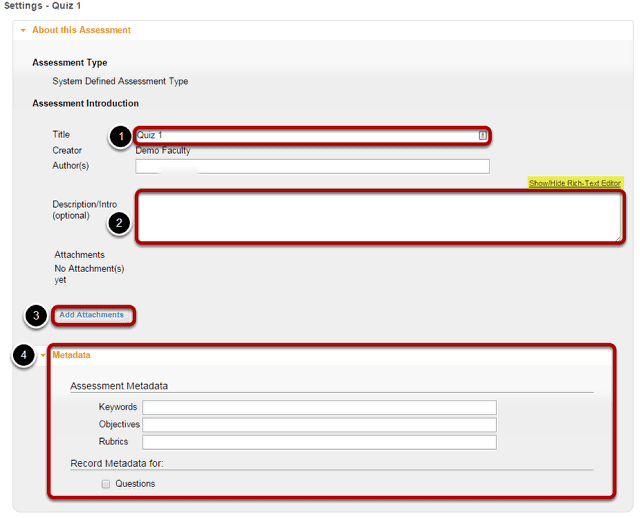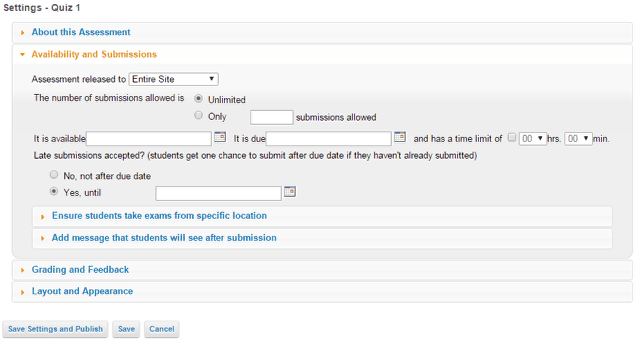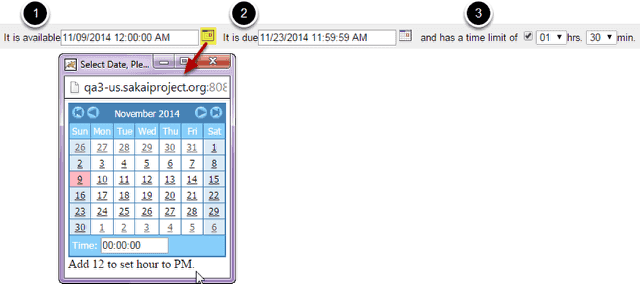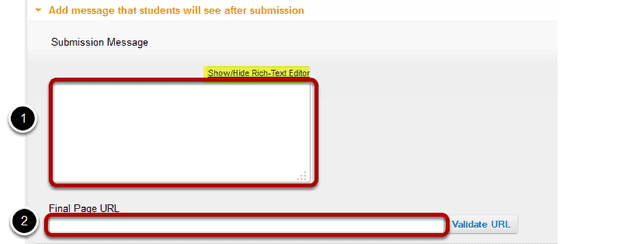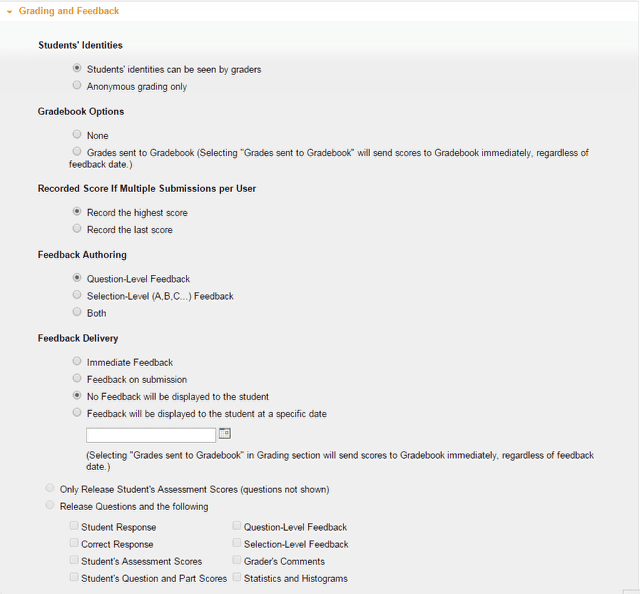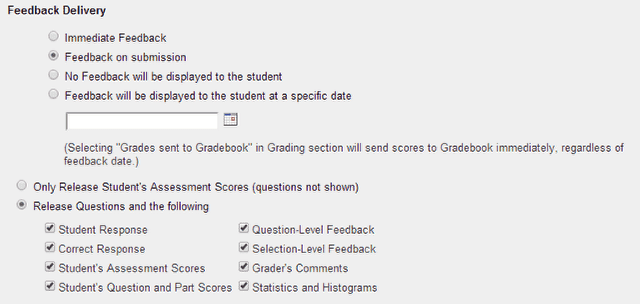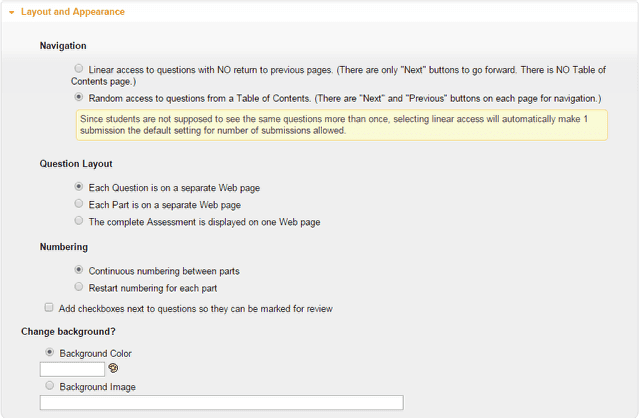How do I inspect and adjust the settings of an assessment?
The settings of a test or quiz are complex, and offer many options. In many cases, the default values will work, but should be reviewed. The modification of a setting in one section will not change settings in other sections.
Go to Tests & Quizzes.
Select the Tests & Quizzes tool from the Tool Menu of your course.
Edit the settings.
From the Tests & Quizzes tool home screen, choose the Settings option in the drop-down menu for the quiz you would like to publish.
Be sure that you are in the Working Copies tab, otherwise, you won't see your unpublished items.
Alternately, you can access assessment settings from the edit assessment screen.
If you are currently editing the quiz in question, click the Settings link at the top of the assessment editing screen.
Settings options.
This is a list of the options available in the assessment settings. Click on the small triangle next to each section to expand/collapse that section.
About this assessment.
The first section is the Assessment Introduction.
- This is where you can change the title of your assessment if desired, and add authors' names.
- Optionally, you may also add a description. Anything you enter into the description field will be visible to students before they begin the assessment. Notice that the Rich Text Editor is available in the description field.
- You can attach a file if you like. The file could be a reference the students need to use during the test, or more detailed instructions on test taking requirements.
- The Metadata section may be optionally expanded to enter additional information about the assessment.
Availability and Submissions
The availability and Submission section controls when your assesment is available and which users have access to it.
Availability and Submissions: Assessment Released to.

By default, the assessment will be released to the Entire Site. If you would like the assessment to be released to Anonymous Users (i.e. users outside the current course) or Selected Groups within your course, select the appropriate radio button. (The groups option is only available if there are existing groups in your site.)
Note: If you release an assessment to anonymous users, you must distribute its URL to participants; it will not be accessible from within your site's Tests & Quizzes tool. The URL will be presented when you publish the assessment.
Availability and Submissions: Number of submissions.

Enter the number of times students are allowed to submit the assessment, or choose Unlimited to let them submit as many times as they like.
Tip: Unlimited submissions are often used for self-assessment, practice tests, or drills.
Availability and Submissions: Delivery Dates and Time Limit
The delivery dates let you specify the availability window for your assessment. You may enter the dates into the fields provided, or use the date-picker (calendar window) to select a date and time.
- The Available Date is the start date of the exam window. Students will not be able to see the assessment before this date.
- The Due Date is the end date for the exam window. Students will not be able to submit after this date unless you allow late submissions. If late submissions are allowed, any submissions after the due date will be marked as late.
- If you would like a Time Limit on your assessment to be timed, select the check box for has a time limit of and select the desired time in hours and minutes from the drop-down menus.
Tip: If you want an assessment to always be open, you may leave the date fields blank.
Availability and Submissions: Late handling.
Choose whether or not you will accept late submissions. If you do allow late submissions, they will be marked as late if they come in after the due date. Use the date picker to select a deadline for late submissions.
Note: Even if you allow multiple submissions, only one late submission is allowed after the due date, and it only applies to students who have not submitted at all.
Availability and Submissions: Exam security by location or password.
For high stakes testing, you may want to provide additional security for your assessment. Click on the Ensure students take exams from specific location link to expand that section and display the following options.
- You may restrict the assessment so that only connections from certain IP addresses are allowed, such as the testing center on campus. Enter one IP per line. Asterisks may be used to stand for any single subnet.
- You may also specify an additional username and password for the assessment. This information is typically provided to a proctor who enters the information for the student at the testing center.
Note: The username and password here are for this specific assessment, and NOT the instructor's or the student's login information.
Availability and Submissions: Submission message.
- If you would like to enter a message that students see upon submitting their assessment, you may do so here. The rich-text editor is available if desired.
- You may include a URL if you like. The URL link for this page will be displayed after the student submits the test.
Availability and Submissions: Automatic submission.
Check this box if you want assessments to be auto-submitted after the retract date.
Note: You will only see this option if it is enabled on your instance. By default, it is not enabled.
Grading and Feedback
This section deals with the grading and feedback options for your assessment.
Grading and Feedback: Student's identities.

The default setting here is Student identities can be seen by graders. In most cases, you want to keep this setting, since there is no way to revert to student names once they have submitted the assessment anonymously.
However, if you are using the Tests & Quizzes tool to deliver a survey in your course, you may want to make the survey submissions anonymous by selecting Anonymous grading only.
Grading and Feedback: Gradebook options.
Gradebook Options include None (the default) or Grades sent to Gradebook. Select to send grades to gradebook if you want to be able to calculate them as part of the course grade.
Grading and Feedback: Recorded Score.

Recorded Score options include either the highest or the last score submitted. If you allow multiple attempts, select the type of score that you want to be recorded in the gradebook for that assessment.
Grading and Feedback: Feedback authoring.
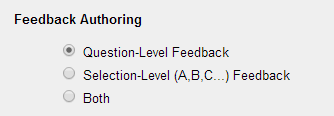
For Feedback Authoring, the default option is Question-Level Feedback. This allows the instructor to author feedback at the question level. You may also choose to display Selection-Level Feedback (i.e. feedback per answer choice), or Both.
Grading and Feedback: Feedback delivery.
Feedback Delivery controls if and when students are able see their submission results.
- Immediate feedback is recommended for self-tests only, as it will display the answers immediately - PRIOR to the student submitting the assessment.
- Feedback on submission displays feedback to students as soon as they submit the assessment.
- No Feedback (the default setting) does not display any feedback to the student.
- Feedback on a specific date releases assessment feedback upon the date and time specified.
You can also decide how much feedback you want to release to students.
- You can choose to Only Release Student's Assessment Scores so that they only see their grade on the assessment, not individual questions.
- Or, you can choose to Release Question and the following and then select the items that you want students to see from the list below. Check the box next to any items you want students to see.
Tip: If you are concerned about students sharing their exam results with one another, you should choose either No Feedback or Feedback on a specific date. For the latter, selecting a date after the closing date for the assessment will prevent students from sharing feedback with other students who have not yet taken the test.
Layout and Appearance
This section has to do with the appearance of the assessment and how students navigate through the test.
Layout and Appearance: Navigation.
Navigation controls how students proceed through the test. The default is Random access where students can navigate through the test with Next and Previous buttons, as well as a Table of Contents. You may change this to Linear access if you prefer, where students can only go forward using the Next button and cannot revisit earlier questions or access a Table of Contents to jump to a question.
Layout and Appearance: Question Layout.

You can control the presentation of the questions according to the options shown. To display the entire assessment on a single Web page, allowing students to scroll through it, click the third choice.
Layout and Appearance: Numbering and allowing Mark for Review.

- Choose the numbering pattern here. Numbering can be either Continuous throughout the test, or can Restart for each part. (For example, if you have multiple parts in the exam and the second part is for essay questions, you could have the numbering go back to 1 for the first essay question.) If you restart numbering for each part, questions are numbered with the part number, then the question number.
- If you want to allow students to mark questions to go back to, check the box for this item. Students may use this option to mark questions that they aren't sure about, and then jump back to them via the Table of Contents to review before submitting.
Note: You cannot allow Mark for Review if Linear access navigation is selected.
Layout and Appearance: Background color.

You can choose a color or image for the background here. To select the colors, click the palette icon. The image is given by a URL. An image smaller than the screen will be tiled for to cover the entire screen area.
Note: It is typically a best practice to leave the background of the assessment a solid color which provides good color contrast between text and background (e.g. a white background with black text) so that students can easily read the questions. Background images may make the assessment difficult to read if images compete with the text.
Effects of settings.
You can modify the settings, parts, and questions of any assessment listed under "Pending Assessments". When you publish an assessment, a copy is created and listed under "Published Assessments". For the published copy, you can make changes to all the settings except "Assessment Released To".
Note: After you've published an assessment, if you modify the unpublished version under "Pending Assessments", you'll have to alter the assessment's name before republishing it. When you publish it, you'll be creating another publication under "Published Assessments", not replacing the existing published copy. Also, if you modify the settings of a test while students are taking it, the changes will not affect testing sessions in progress. Students must exit the test and re-enter it in order to have the modified settings take effect.
Publish the assessment.

When the assessment settings are ready, and the questions are in place, publish the assessment so that your students can take it. See the article How do I publish an assessment (i.e. test or quiz)?
